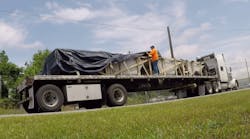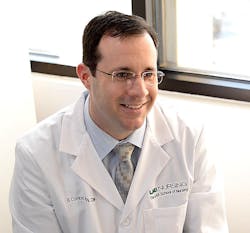Health care providers and truckers know that back problems are drivers' most common occupational injury, but what's second?
That's what Bryan Combs, faculty member and nurse at the University of Alabama at Birmingham, wanted to find out. And what he discovered may change the way drivers' injuries are diagnosed and treated.
Combs, who was an athletic trainer before becoming a nurse and instructor, learned that shoulder injuries were the second most common driver injury, but, even more important, it took longer to heal, cost more downtime, and often required more extensive treatments than back problems.
When he began studying the issue, he found how little was known about drivers and shoulder injuries, and wondered why. "I don't have a great reason," he said. "One answer may be that because back injuries are so prevalent, there have been a lot of studies on them. It's the first thing you think of when it comes to truck driver injuries. There have been studies about shoulder injuries in nurses, electricians and construction workers but not with drivers. It's just not on the radar unless you know them [drivers] and work with them."
Combs added that many health care professionals think of truck drivers as only sitting behind the wheel for long periods of time which immediately suggests back injuries. "They don't think about the labor of getting in and out of the cab, especially if it's wet, or dealing with tarps, straps and chains."
Combs also said he believes that drivers' being overweight may be a risk factor in shoulder injuries from climbing in and out of the cab.
Although he cannot say for sure, Combs posits that shoulder injuries may be more prevalent in drivers who pull flatbeds because of overexertion in using chains and tarps. The problem is that no one has ever looked into injuries surrounding these specific tasks.
Why do shoulder injuries take more time to heal, produce more downtime and cost more than back injuries? Anatomically speaking, shoulders are extremely complicated and in some ways more intricate than backs.
"The reason we think that they (shoulder injuries) take much longer to get over is because a lot of them require surgery. They're going to involve either a rotator cuff tear or perhaps involve a labral tear or both. That's what we think, but we just don't know yet for sure," Combs noted. (The labrum is a ring of cartilage surrounding the shoulder. It is a common injury location among athletes who engage in repetitive throwing or overhead motions, such as baseball, volleyball and football.)
Combs won an award from the National Association of Orthopaedic Nurses for his study Shoulder Injuries in Commercial Truck Drivers: A Literature Review, which was co-written by his mentor, associate professor Karen Heaton, Ph.D. With her assistance he plans to go further and learn more about truckers' shoulder injuries and how to prevent them. To do this he will have to find data that teases out drivers who tarp and those who don't.
"I hope to find a large number of commercial truck drivers seen in this clinic who have shoulder injuries and learn if it's related to tarps and straps and chains. If so, that may support a bigger study, a more prospective study, maybe we can get funding to look at even more drivers. This would allow us to identify people who may be just tarpers or just drivers or drivers who tarp," Combs explained.
Combs likes to think of drivers as “occupational athletes” who suffer much of the same injuries as college or professional athletes.
"If I find that truck drivers have increased risk for rotator cuff tears and labral tears, even though they may already be an unhealthy population with increased BMI and chronic diseases, it makes sense that we should have a rotator cuff program similar to ones for quarterbacks and pitchers,” he noted. “It could be a short ten to fifteen-minute rotator cuff strengthening program to help prevent injuries, again, the same way that I would handle quarterbacks. If you can strengthen the shoulder, think of drivers as occupational athletes, we may be able to do something to help prevent shoulder injuries."




